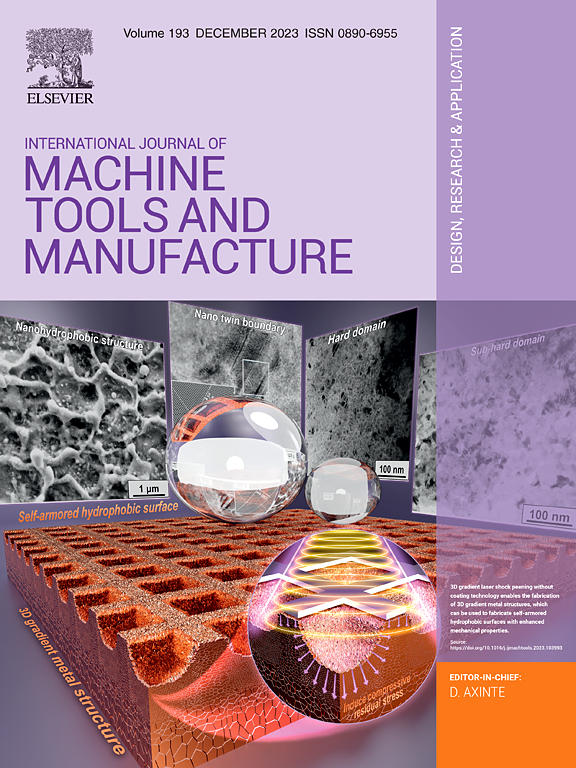Systematic review of Cutting Force Measuring Systems in machining: Principles, design, filtering techniques and applications
IF 18.8
1区 工程技术
Q1 ENGINEERING, MANUFACTURING
International Journal of Machine Tools & Manufacture
Pub Date : 2025-07-12
DOI:10.1016/j.ijmachtools.2025.104308
引用次数: 0
Abstract
Cutting force measurement plays a key role in modern manufacturing, supporting machinability testing, tool development, process optimization, real-time monitoring and control, and indirect evaluation of part quality. Over the past 50 years, numerous Cutting Force Measuring Systems (CFMS) have been developed and applied successfully in both laboratory and industrial settings. However, their adoption in real industrial environments has been limited by several practical drawbacks. Today, the need for more effective, less invasive, and lower-cost sensing solutions is driving renewed interest in CFMS and fostering deeper integration into manufacturing systems. Despite their relevance, comprehensive and updated reviews of CFMS are scarce. This systematic review aims to present the fundamental principles of cutting force sensing, outline the main types of CFMS, and provide general design guidelines. The strengths and limitations of each type of CFMS are discussed and compared—particularly their limited frequency bandwidth, which can be further reduced when integrated into actual machining systems. To address these challenges, advanced identification and filtering techniques are described, focusing on the dynamic relationship between input forces and measured outputs, along with modern methods for their determination. Parametric (Kalman) filters are introduced, while greater emphasis is placed on recent non-parametric filters, which offer easier implementation in industrial contexts. The review also highlights key CFMS applications, including machinability testing, cutting force model identification, tool development and tool condition monitoring. Emerging trends are examined, such as PVDF-based sensors, the Universal Inverse Filter, and other innovative technologies. Current research challenges involve developing solutions for wireless power transmission, fast calibration, low-latency data transfer, and embedded signal processing. Continued progress in CFMS research and application will be essential to advancing intelligent manufacturing and improving industrial competitiveness.

机械加工中切削力测量系统综述:原理、设计、滤波技术和应用
切削力测量在现代制造业中起着关键作用,它支持可加工性测试、刀具开发、工艺优化、实时监测和控制以及零件质量的间接评价。在过去的50年里,许多切削力测量系统(CFMS)已经被开发出来并成功地应用于实验室和工业环境中。然而,它们在实际工业环境中的应用受到一些实际缺陷的限制。如今,对更有效、侵入性更低、成本更低的传感解决方案的需求正在推动人们对CFMS的重新关注,并促进与制造系统的更深层次集成。尽管它们具有相关性,但对CFMS的全面和更新的评论很少。本系统综述旨在介绍切削力传感的基本原理,概述CFMS的主要类型,并提供一般设计指南。讨论和比较了每种类型CFMS的优点和局限性,特别是它们的有限频率带宽,当集成到实际加工系统中时,可以进一步降低其带宽。为了解决这些挑战,介绍了先进的识别和过滤技术,重点是输入力和测量输出之间的动态关系,以及它们的实验识别的现代方法。介绍了参数(卡尔曼)滤波器,同时更强调最近的非参数滤波器,它们在工业环境中更容易实现。该综述还强调了CFMS的关键应用,包括可加工性测试、切削力模型识别、刀具开发和刀具状态监测。研究了新兴趋势,如基于pvdf的传感器,通用反滤波器和其他创新技术。目前的研究挑战包括开发无线电力传输、快速校准、低延迟数据传输和嵌入式信号处理的解决方案。不断推进CFMS研究和应用,对推进智能制造和提高产业竞争力至关重要。
本文章由计算机程序翻译,如有差异,请以英文原文为准。
求助全文
约1分钟内获得全文
求助全文
来源期刊
CiteScore
25.70
自引率
10.00%
发文量
66
审稿时长
18 days
期刊介绍:
The International Journal of Machine Tools and Manufacture is dedicated to advancing scientific comprehension of the fundamental mechanics involved in processes and machines utilized in the manufacturing of engineering components. While the primary focus is on metals, the journal also explores applications in composites, ceramics, and other structural or functional materials. The coverage includes a diverse range of topics:
- Essential mechanics of processes involving material removal, accretion, and deformation, encompassing solid, semi-solid, or particulate forms.
- Significant scientific advancements in existing or new processes and machines.
- In-depth characterization of workpiece materials (structure/surfaces) through advanced techniques (e.g., SEM, EDS, TEM, EBSD, AES, Raman spectroscopy) to unveil new phenomenological aspects governing manufacturing processes.
- Tool design, utilization, and comprehensive studies of failure mechanisms.
- Innovative concepts of machine tools, fixtures, and tool holders supported by modeling and demonstrations relevant to manufacturing processes within the journal's scope.
- Novel scientific contributions exploring interactions between the machine tool, control system, software design, and processes.
- Studies elucidating specific mechanisms governing niche processes (e.g., ultra-high precision, nano/atomic level manufacturing with either mechanical or non-mechanical "tools").
- Innovative approaches, underpinned by thorough scientific analysis, addressing emerging or breakthrough processes (e.g., bio-inspired manufacturing) and/or applications (e.g., ultra-high precision optics).

 求助内容:
求助内容: 应助结果提醒方式:
应助结果提醒方式:


